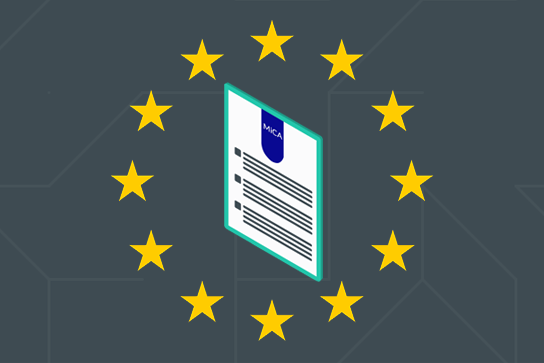
The Ultimate Guide to MiCA's Electronic Money Tokens (EMTS)
Title IV of REGULATION (EU) 2023/1114 OF THE EUROPEAN PARLIAMENT AND OF THE COUNCIL of 31 May 2023 on markets in crypto-assets, and amending Regulations (EU) No 1093/2010 and (EU) No 1095/2010 and Directives 2013/36/EU and (EU) 2019/1937 - referred to as MiCA going forward - provides the regulations that crypto-asset service providers (CASPs) must comply with regarding the issuance and holding of EMTs.
This blog discusses MiCA’s Title IV in detail, Article by Article. Please note this blog is meant to be used as a guide. To ensure 100% compliance, it is recommended that the whole MiCA document be read.
What CASPs Need to Know about Electronic Money Tokens (EMTs)
Chapter 1: Requirements to Be Fulfilled by All Issuers of Electronic Money Tokens
Below, key elements of EMTs are discussed. This includes requirements for public offers or trading admission, issuance and redemption processes, prohibition of interest, and criteria for crypto-asset white papers. Moreover, issuer liabilities, marketing regulations, investment practices, and recovery plans will be examined.
Article 48: Requirements for the Offer to the Public or Admission to Trading of Electronic Tokens
Only authorised credit or electronic money institutions can issue EMTs, providing a crypto-asset white paper to the jurisdiction’s competent authority. EMTs are electronic money, subject to EU directives unless exempted under Article 9(1) of Directive 2009/110/EC as specific provisions don't apply to exempted tokens. Issuers must notify their authority 40 working days before public offerings. Even with exemptions, a crypto-asset white paper must be prepared and notified to the authority.
Article 49: Issuance and Redeemability of Electronic Money Tokens
Issuers of EMTs are subject only to the requirements outlined in this Article, differing from Directive 2009/110/EC's provisions. Holders of EMTs have a claim against the issuer; issuers must issue tokens at the same value as the funds received. Moreover, EMTs can be redeemed at any time by the holder. The conditions for redemption must be clearly stated in the crypto-asset white paper, as per Article 51(1)(d). The redemption of EMTs is exempt from fees (excluding Article 46’s provisions).
Article 50: Prohibition of Granting Interest
Issuers are forbidden to grant interest in relation to EMTs, contrary to Article 12 of Directive 2009/110/EC. CASPs offering services related to EMTs are also prohibited from granting interest. Moreover, any form of remuneration or benefit based on the duration of holding EMTs is considered interest. This includes compensation, discounts, or benefits directly associated with the token received from the issuer or third parties.
Article 51: Content and Form of the Crypto-asset White Paper for Electronic Money Tokens
The crypto-asset white paper for EMTs must include details about the issuer, token offering or trading admission, token rights and obligations, underlying technology, risks, and environmental impacts. All information must be clear, accurate, and concise, with a prominent disclaimer stating the paper's lack of approval and issuer responsibility.
It must also warn that the token isn't covered by investor compensation or deposit guarantee schemes. The issuer must provide specified information to the competent authority alongside the white paper notification. ESMA and EBA will develop regulatory standards for environmental impacts, considering factors like energy use and emissions, with updates expected by June 30, 2024.
Article 52: Liability of Issuers of Electronic Money Tokens for the Information given in a Crypto-asset White Paper
Issuers of EMTs are liable for information provided in the crypto-asset white paper. If the white paper contains incomplete, unfair, unclear, or misleading information, the issuer and its administrative bodies are liable for any resulting losses to token holders. Contractual liability limitations are ineffective.
Token holders must prove the issuer's wrongdoing. The issuer isn't liable for losses unless it is proven that the white paper is misleading or lacks critical information. This liability doesn't affect other civil liabilities under national law.
Article 53: Marketing Communications
Marketing communications for EMTs must be marked as such, provide fair and accurate information consistent with the white paper, and include issuer contact details. They must also state holders' redemption rights and be published on the issuer's website. Approval from authorities is optional, but communications must be provided upon request. Except for market soundings, marketing can't start before the white paper is published.
Article 54: Investment of Funds Received in Exchange for Electronic Money Tokens
Funds received by issuers of EMTs in exchange for tokens must adhere to specific investment guidelines:
At least 30% of received funds must be deposited in separate accounts in credit institutions.
The remaining funds must be invested in secure, low-risk assets meeting the criteria for highly liquid financial instruments with minimal market, credit, and concentration risks. These investments should be denominated in the same official currency as referenced by the EMT.
Article 55: Recovery and Redemption Plans
Recovery plans must be notified to the competent authority within 6 months of the offer to the public or admission to trading, deviating from the standard provision in Article 46(2).
Redemption plans must be notified to the competent authority within 6 months of the offer to the public or admission to trading, differing from the usual requirement stated in Article 47(3).
Chapter 2: Significant Electronic Money Tokens
The following section explains the classification of EMTs, focusing mainly on their categorisation as significant EMTs. This classification holds significant implications for regulatory frameworks and market operations. Additionally, the voluntary classification of EMTs and the specific additional obligations imposed on issuers of EMTs is discussed.
Article 56: Classification of Electronic Money Tokens as Significant Electronic Money Tokens
The process of classifying EMTs as significant involves several steps. The EBA evaluates tokens against specified criteria, considering data from multiple issuers if applicable. Competent authorities report relevant information to the EBA and ECB. Once the EBA determines a token as significant, it notifies stakeholders and allows for observations before making a final decision. If classified as significant, supervisory responsibilities transfer to EBA, with a derogation for tokens concentrated in their home Member State.
Reassessment occurs annually based on available data. If a token no longer meets significance criteria, the EBA notifies stakeholders, allowing for observations. The EBA makes a final decision within 60 working days. If a token is no longer significant, supervisory responsibilities return to the issuer's competent authority.
Article 57: Voluntary Classification of Electronic Money Tokens as Significant Electronic Money Tokens
The process for voluntarily classifying EMTs as significant involves these steps:
Authorised issuers or applicants can request classification by demonstrating the potential to meet at least three criteria outlined in Article 43(1).
The EBA reviews the issuer's program within 20 working days and drafts a decision based on criteria fulfilment, considering stakeholder feedback.
The EBA notifies stakeholders within 60 working days of classification.
If classified as significant, supervisory responsibilities transfer to EBA within 20 working days, with cooperation for a smooth transition. A derogation allows supervisory responsibilities to remain with the issuer's competent authority for tokens primarily in their home Member State, with annual reporting to the EBA.
Article 58: Specific Additional Obligations for Issuers of Electronic Money Tokens
Electronic money institutions issuing significant EMTs must comply with specific requirements outlined in Articles 36, 37, 38, and Article 45(1)-(4) of this Regulation, rather than Directive 2009/110/EC. They must also adhere to requirements in Article 35(2), (3), and (5), as well as Article 45(5) of this Regulation. Independent audits are mandated every 6 months following classification.
Competent authorities of home Member States can enforce requirements for electronic money institutions issuing non-significant EMTs to mitigate risks such as liquidity or operational issues. Articles 22, 23, and 24(3) apply to EMTs denominated in non-official currencies of Member States.
Learn more about the European Union’s Travel Rule requirements - reach out to us today.



